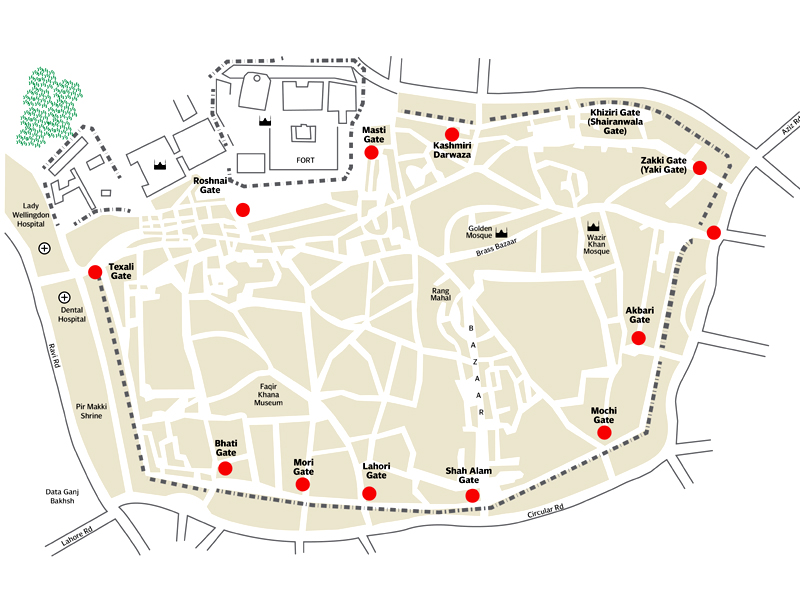
Six of the remaining 12 gates of the walled city of
Lahore are being rescued. The Walled City of Lahore Authority is putting millions of rupees into the project with the help of the Aga Khan Trust for Culture. Experts will start with the Texali and Shah Alam gates. They will, however, be modeled on the Roshnai gate, which was built in the Mughal style, said a restorer. It appears that Sikh or British styles will be eschewed.
The old city of Lahore came to be known during the reign of Emperor Akbar (1584-1598) as the walled city because it was enclosed by a nine-metre high brick wall with a rampart. The walled city had 13 gates made of wood and iron. They continued to exist until the 19th century but the British are said to have demolished them in an attempt to weaken the defences. Almost all of the gates, except Roshnai Gate, were felled. Except for the Delhi and Lahori Gates, all of them were rebuilt but sadly today, only six continue to exist: Roshnai, Delhi, Shairanwalla, Bhati, Kashmiri and Lahori gates. Here is a bird’s-eye view:

Roshnai Gate
Roshnai Gate lies between the Lahore Fort and Badshahi Mosque and is still in its original condition. It was the main entrance from the fort to the city and was specifically used for courtiers, royal servants and their retinues. In the evenings the gate was lit up, giving it the name Roshnai or light. Next door is Hazuri Bagh, created by Maharajah Ranjit Singh in 1813 to celebrate the capture of the Koh-i-Noor diamond from Shah Shujah of Afghanistan. In the centre of the garden stands the Hazuri Bagh Baradari in marble. The mausoleum of poet Muhammad Iqbal and the Samadhi of Ranjit Singh are worth a visit here.
Masti Gate
Its name derives from the word Masjidi as the mosque of Mariam Makhani, the mother of Emperor Akbar, is located in its immediate locality. Some historians assert that the gate was named after Masti Baloch, who was appointed a guard. This area is primarily packed with shoe vendors today.
Texali Gate
The royal mint or Taxal was located near this gate, lending it its name. Today this area is renowned for its appetising range of food. The bazaar is also the place to go to for musical instruments that are made and sold here. The sacred places for the Sikhs, Pani-Wallah Talaab and Gurdwara Lal Khooh are also located here.
Bhati Gate

Named after the ancient Bhat Rajput tribe, Bhati gate is renowned for Lahori food. Its Bazaar-e-Hakiman was named after the hakims, who lived here. Poet Dr Allama Iqbal had a small place here where he used to study and hold daily meetings with his comrades; it still exists. Prominent pahalwans or wrestlers such as Kala Maro lived here.
Mori Gate

Sandwiched between Lahori and Bhati gates was the small Mori gate, even though it wasn’t a gate as such. In Urdu, the word mori is used to referred to a small hole. In the evening, when all of the gates were closed, this particular opening gave access to the walled city. It was also used as an outlet for garbage disposal. The striking structures are still witnessing the glory and magnificence of the bygone empires; however, advertisement of different shops, banners of political parties, pollution and uncleanliness of the vicinity are heavily costing the splendor of the Mughal art.
Lahori Gate
The oldest of the gates of the walled city, Lahori Gate is colloquially known as Lohari Gate. During Hindu Raj, the neighbourhood of Ichra was supposed to be the actual Lahore. As this gate faced Ichra, it was thus named Lahori Gate. However, another group of historians claims that Lohari comes from Urdu word loha or iron. Lohars or blacksmiths used to run their business here. Just across this gate you will find Anarkali Bazaar and the tomb of Qutubuddin Aibak, first Muslim ruler of the subcontinent.
Kashmiri Darwaza

This gate opens towards the valley of Kashmir. Inside visit the Kashmiri Bazaar with narrow markets and alleyways. A pathway leads to the famed and impossibly tranquil Wazir Khan Mosque. A big market for children’s shoes spreads out from it.
Khiziri Gate (Shairanwala Gate)
It is said that this gate was named after a saint, Hazrat Khwaja Khizr Elias, who was known as Amer-ul-Bahar (commander of water). At the time it was built this gate opened onto the river front. Some historians assert that when Sher-e-Punjab Maharaja Ranjit Singh got hold of the city, he kept two domesticated lions in a cage for protection, which is why this gate was named Shairanwala or Lions gate.
Zakki Gate (Yaki Gate)
Zakki Gate has a bit of a surprising story. It was named after a saint, Zakki, who historians say was beheaded during a fight against the Tartars. It is said that even after his head was severed from his body, the body continued fighting for some time. His head and body are said to be buried at the spots where they fell. A number of temples are also located in and around this gate.
Delhi Gate:

This gate was built during the reign of Emperor Akbar and is named as such as it opens towards Delhi, which was the then capital of the Mughal dynasty. Just as you enter, to the left is the rehabilitated royal bath or Shahi Hamam built by Hakim Ilmuddin. A short walk up ahead will lead you to Wazir Khan Mosque with its intricate painted panels. The tomb of Hazrat Meran Badshah is located in the courtyard of the mosque. Hindus also revere the Shawala Baba Bhakar Guru site in this neighbourhood.
Akbari Gate:
Named after Jalalud Din Muhammad Akbar (1542-1605), Akbari Gate is located in the east. Akbari Mandi, the biggest wholesale and retail market of Lahore for grains and spices, was set up by the emperor and serves thousands even today.
Mochi Gate:
Morchi or trench soldier seems to be the word that led to Mochi Gate. This etymological origin is supported by the fact that some streets or mohallas in the area still bear names like Mohalla Teer-garan (arrow craftsmen), Mohalla Kaman-garan (bow craftsmen). Some historians feel that the name came from Moti or pearl after Pandit Moti Ram, a guard during the reign of Akbar who used to watch over this gate. The gate was the main route taken to some Havelis of the Mughal empire such as Mubarak Haveli, Nisar Haveli and Laal Haveli. To its immediate right is Mochi Bagh where political get-togethers take place. Find here dry fruit, kites and fireworks and don’t miss the kebabs and das Kulcha with lonchara for breakfast.
Shah Alam Gate

This gate was named after Aurangzeb’s son and successor, Muazzam Shah Alam Bahadur Shah. It was once called Bherwala Gate and was burnt to ashes in the 1947 rioting; only the name exists today. It opens into one of Lahore’s busiest bazaars, where you can get nearly everything from iron receptacles to wedding accessories. Rang Mahal and Soha Bazaar (the gold market) are also worth a visit. There are almost 400 shops, burning brightly with hundreds of gold and yellow bulbs, to browse. Kanari bazaar is a hot favourite for brides-to-be and Chata bazaar is known for the traditional leather khussa. Go to Gumtee and Dabi Bazars for bangles and Azam Cloth Market for textiles.
Published in The Express Tribune, Sunday Magazine, August 25th, 2013.
Like Express Tribune Magazine on Facebook, follow @ETribuneMag on Twitter to stay informed and join the conversation.
COMMENTS (5)
Comments are moderated and generally will be posted if they are on-topic and not abusive.
For more information, please see our Comments FAQ







































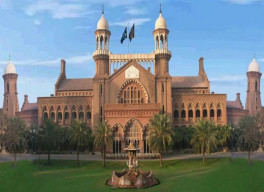

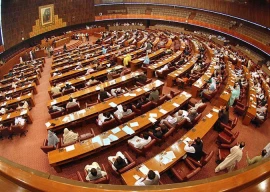
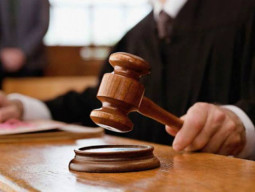
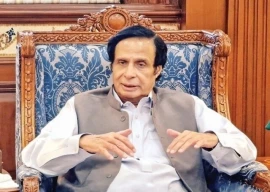
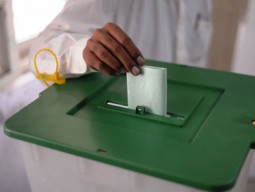





















this work is of much importance i really hope that they complete it with no leaves unturned
Rightly said, Umair. Green architecture ought to be encouraged but at the same time we can never undermine the majesty and significance of our cultural heritage. Ought to be preserved and shared. Nice article!